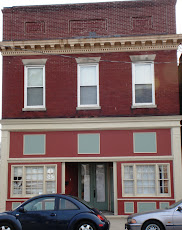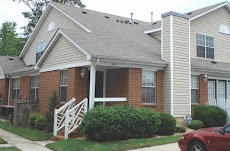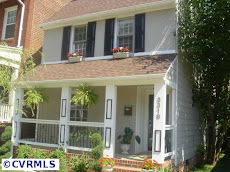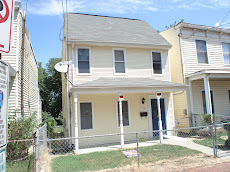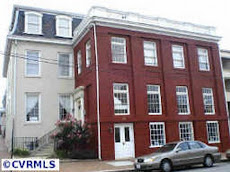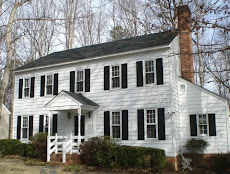It's been a wild week in real estate here in Richmond as buyers rush to find a home to buy before the federal tax credit expires. The deadline for contract to be finalized is April 30th leaving just seven days to act.
For those you coming out of a coma. The federal government is granting an $8,000 refundable income tax credit for first time buyers (and those who haven't owned in the past three years) and $6,500 for move-up buyer as part of the stimulus package.
I think some people falsely thought or were hoping for a second extension of this program. This highly unlikely to happen (though I would love to be proven wrong on this point). So this is probably the last train out for such great program.
The tax credit has been a real bright spot on an otherwise gloomy real estate market. It is great to have a least one government program that works and puts money back into regular folks pockets and back out into the local economy. Lots of economic activity accompanies every single home sale with ancillary purchases of furniture, appliances, do-it-yourself home project supplies, movers, mortgages, title companies, realtors, utilities, inspectors, contractors, interior designers, florists, insurers, the list goes on.
The housing sector in a major engine of the economy on both a macro and micro level, so get out there and do your patriotic duty to spur on the economy! So much for my soapbox. I do feel that I am doing my part. I just set two appoinments to show my Fan listings while writing this submission. One of those agents said he was showing twelve different condos today - Whew!
Anyway the real test is to see what happens after the credit expires. We are hoping things just get back to a normal pace in the market. We are still in a great environment for puchases with interest rates just above five percent as of yesterday and an a market where sellers are willing to help out with the buyer's closing costs. Also there are some great deals on foreclosed properties. The banks that own these are very competitive in the market and a good number are in decent condition.
Well, I better get back to work. I just got another request to show a listing a 4:00 pm. It great to have a rush. Keep it coming...
Saturday, April 24, 2010
Friday, April 23, 2010
"Loft Curious" in Richmond
We recently had a Downtown Loft tour in Richmond showcasing loft living for sale and rent in the Dowtown area including Jackson Ward, City Center, Shockoe Bottom, Manchester, Rocketts Landing, and along the Riverfront/Canal Walk.
This event was sponsored by Venture Richmond and a group of volunteers. We provided a loop of GRTC buses to run continuously on a fixed route between all the sites which included: 401 Brook Lofts in Jackson Ward, Miller & Rhoads Residences in City Center, Consolidated Building in Shockoe Bottom, The Lofts at Canal Walk, Warehouse 201 and The Manchester Pie Factory in Manchester,Vistas on the James in Shockoe Slip, and Finally Skyline at Rocketts Landing.
I worked as a greeter at the Manchester Pie Factory. What was so interesting was the people that showed up for the tour. This was my first year being involved and I had the expectation that it would be young professional and hipster types, but was not. Most of the folks there were from the suburbs and were nouveau loft curious.
It says allot about the change in the market that we are seeing here in Richmond where people who previously moved South or West to the outer suburbs are now interested in coming back to an urban environment. Perhaps the outer suburbs have gone as for as they can go in terms of commute times or people are more interested in the amenities or "walkability" of an area.
We are seeing "New Urban" developments slowly developing in the area such as Rockett's Landing, West Broad Village in Richmond and New Town in Williamsburg. These development offer the walkability and convenience of an urban location but are lacking in authenticity and diversity.
Ask the people around you and you'll find more and more people talking about how nice it is the places like the Fan District, Jackson Ward, Downtown, Shockoe Bottom and Manchester. This is where the energy and buzz is about in Richmond.
I personally was drawn to the inner city because of the sense of community one feels in an urban environment where you have no choice but to know your neighbors because they are physically close to you. Also the option of parking your car when you come home and walking whatever you need is a very refreshing alternative to having to drive for everything.
I, like many of the others on the Loft tour moved to the city from the suburbs. I my case Williamsburg. I hope this trend continues and makes are city keep growing.
This event was sponsored by Venture Richmond and a group of volunteers. We provided a loop of GRTC buses to run continuously on a fixed route between all the sites which included: 401 Brook Lofts in Jackson Ward, Miller & Rhoads Residences in City Center, Consolidated Building in Shockoe Bottom, The Lofts at Canal Walk, Warehouse 201 and The Manchester Pie Factory in Manchester,Vistas on the James in Shockoe Slip, and Finally Skyline at Rocketts Landing.
I worked as a greeter at the Manchester Pie Factory. What was so interesting was the people that showed up for the tour. This was my first year being involved and I had the expectation that it would be young professional and hipster types, but was not. Most of the folks there were from the suburbs and were nouveau loft curious.
It says allot about the change in the market that we are seeing here in Richmond where people who previously moved South or West to the outer suburbs are now interested in coming back to an urban environment. Perhaps the outer suburbs have gone as for as they can go in terms of commute times or people are more interested in the amenities or "walkability" of an area.
We are seeing "New Urban" developments slowly developing in the area such as Rockett's Landing, West Broad Village in Richmond and New Town in Williamsburg. These development offer the walkability and convenience of an urban location but are lacking in authenticity and diversity.
Ask the people around you and you'll find more and more people talking about how nice it is the places like the Fan District, Jackson Ward, Downtown, Shockoe Bottom and Manchester. This is where the energy and buzz is about in Richmond.
I personally was drawn to the inner city because of the sense of community one feels in an urban environment where you have no choice but to know your neighbors because they are physically close to you. Also the option of parking your car when you come home and walking whatever you need is a very refreshing alternative to having to drive for everything.
I, like many of the others on the Loft tour moved to the city from the suburbs. I my case Williamsburg. I hope this trend continues and makes are city keep growing.
Top Architecture Awards to Richmond Projects
The commercial real estate market has slowed down over the last couple of years, but that didn’t stop hundred of professionals from gathering last night to celebrate the best new projects in the Richmond.
Movieland at Boulevard Square was recognized as Project of the Year at the ninth annual Real Estate Awards Gala presented by GRACRE.
Movieland transformed the Richmond Steel Building at Leigh Street and Boulevard into the city’s only multiplex. It opened last February. The theater is owned by New York-based Bow Tie Partners. The architect was Commonwealth Architects and the contractor was CD Hall Companies.
The best retail or restaurant project award went to The Boathouse at Rocketts Landing. The developer was Kevin Healy and the WVS Companies. Architect Johannas Design Group, interior designer HL Reed Design and contractor J.D. Lewis Construction Management shared the recognition.
“I hired the right people,” said restaurant owner Kevin Healy before the awards were given out on how he felt to be nominated.
Healey said he was interested in the property, a former power plant that once was used to charge city street cars, before WVS even began marketing it. His restaurant opened last August and he said so far the vision has been a success and will only improve as more people move to the area.
Suburban retail developments Rutland Commons and Westchester Commons were also nominated for the same award.
Debbie Wake, the president of GRACRE, said she was pleasantly surprised by the record number of nominations this year.
“I think last year we were worried if we would haven enough project to field a program in 2010,” Wake said.
The nominations were narrowed down to 37 finalists and a panel of judges selected the 12 award winners.
Below is a list of the winning projects:
Project of the Year: Movieland at Boulevard Square
Best Retail or Restaurant Project: The Boathouse at Rocketts Landing
Best Institutional or Public Project: VCU Molecular Medicine Research Building
Honorable Mention, Institutional or Public Project: VCU Walter L. Rice Education Building
Best Interior Project: Altria Client Services Headquarters Annex
Best Mixed Use Project: Hilton Garden Inn/Miller and Rhoads
Best Multi-Family Project: Mayton Transfer Lofts
Best Office Building: MeadWestvaco Headquarters
Best R&D, Flex, or Industrial Project: GRTC Transit System Corporate Headquarters
Best Recreational, Entertainment or Hotel Project: Richmond CenterStage
Best Renovated or Historical Rehabilitation Project: The Power Plant at Rocketts Landing
Deal of the Year Lease: BB&T at Riverfront Plaza
Deal of the Year Purchase: Culpepper Farms & Oaks at Gayton Apartments
About Us
Contributors/StaffDaily NewsFeedSpeaking/ Appearances And the award for best commercial real estate project goes to
April 22, 2010 by Al Harris
Movieland at Boulevard Square was recognized as Project of the Year at the ninth annual Real Estate Awards Gala presented by GRACRE.
Movieland transformed the Richmond Steel Building at Leigh Street and Boulevard into the city’s only multiplex. It opened last February. The theater is owned by New York-based Bow Tie Partners. The architect was Commonwealth Architects and the contractor was CD Hall Companies.
The best retail or restaurant project award went to The Boathouse at Rocketts Landing. The developer was Kevin Healy and the WVS Companies. Architect Johannas Design Group, interior designer HL Reed Design and contractor J.D. Lewis Construction Management shared the recognition.
“I hired the right people,” said restaurant owner Kevin Healy before the awards were given out on how he felt to be nominated.
Healey said he was interested in the property, a former power plant that once was used to charge city street cars, before WVS even began marketing it. His restaurant opened last August and he said so far the vision has been a success and will only improve as more people move to the area.
Suburban retail developments Rutland Commons and Westchester Commons were also nominated for the same award.
Debbie Wake, the president of GRACRE, said she was pleasantly surprised by the record number of nominations this year.
“I think last year we were worried if we would haven enough project to field a program in 2010,” Wake said.
The nominations were narrowed down to 37 finalists and a panel of judges selected the 12 award winners.
Below is a list of the winning projects:
Project of the Year: Movieland at Boulevard Square
Best Retail or Restaurant Project: The Boathouse at Rocketts Landing
Best Institutional or Public Project: VCU Molecular Medicine Research Building
Honorable Mention, Institutional or Public Project: VCU Walter L. Rice Education Building
Best Interior Project: Altria Client Services Headquarters Annex
Best Mixed Use Project: Hilton Garden Inn/Miller and Rhoads
Best Multi-Family Project: Mayton Transfer Lofts
Best Office Building: MeadWestvaco Headquarters
Best R&D, Flex, or Industrial Project: GRTC Transit System Corporate Headquarters
Best Recreational, Entertainment or Hotel Project: Richmond CenterStage
Best Renovated or Historical Rehabilitation Project: The Power Plant at Rocketts Landing
Deal of the Year Lease: BB&T at Riverfront Plaza
Deal of the Year Purchase: Culpepper Farms & Oaks at Gayton Apartments
About Us
Contributors/StaffDaily NewsFeedSpeaking/ Appearances And the award for best commercial real estate project goes to
April 22, 2010 by Al Harris
Top Architure Awards to Richmond Projects
The commercial real estate market has slowed down over the last couple of years, but that didn’t stop hundred of professionals from gathering last night to celebrate the best new projects in the Richmond.
Movieland at Boulevard Square was recognized as Project of the Year at the ninth annual Real Estate Awards Gala presented by GRACRE.
Movieland transformed the Richmond Steel Building at Leigh Street and Boulevard into the city’s only multiplex. It opened last February. The theater is owned by New York-based Bow Tie Partners. The architect was Commonwealth Architects and the contractor was CD Hall Companies.
The best retail or restaurant project award went to The Boathouse at Rocketts Landing. The developer was Kevin Healy and the WVS Companies. Architect Johannas Design Group, interior designer HL Reed Design and contractor J.D. Lewis Construction Management shared the recognition.
“I hired the right people,” said restaurant owner Kevin Healy before the awards were given out on how he felt to be nominated.
Healey said he was interested in the property, a former power plant that once was used to charge city street cars, before WVS even began marketing it. His restaurant opened last August and he said so far the vision has been a success and will only improve as more people move to the area.
Suburban retail developments Rutland Commons and Westchester Commons were also nominated for the same award.
Debbie Wake, the president of GRACRE, said she was pleasantly surprised by the record number of nominations this year.
“I think last year we were worried if we would haven enough project to field a program in 2010,” Wake said.
The nominations were narrowed down to 37 finalists and a panel of judges selected the 12 award winners.
Below is a list of the winning projects:
Project of the Year: Movieland at Boulevard Square
Best Retail or Restaurant Project: The Boathouse at Rocketts Landing
Best Institutional or Public Project: VCU Molecular Medicine Research Building
Honorable Mention, Institutional or Public Project: VCU Walter L. Rice Education Building
Best Interior Project: Altria Client Services Headquarters Annex
Best Mixed Use Project: Hilton Garden Inn/Miller and Rhoads
Best Multi-Family Project: Mayton Transfer Lofts
Best Office Building: MeadWestvaco Headquarters
Best R&D, Flex, or Industrial Project: GRTC Transit System Corporate Headquarters
Best Recreational, Entertainment or Hotel Project: Richmond CenterStage
Best Renovated or Historical Rehabilitation Project: The Power Plant at Rocketts Landing
Deal of the Year Lease: BB&T at Riverfront Plaza
Deal of the Year Purchase: Culpepper Farms & Oaks at Gayton Apartments
About Us
Contributors/StaffDaily NewsFeedSpeaking/ Appearances And the award for best commercial real estate project goes to
April 22, 2010 by Al Harris
Movieland at Boulevard Square was recognized as Project of the Year at the ninth annual Real Estate Awards Gala presented by GRACRE.
Movieland transformed the Richmond Steel Building at Leigh Street and Boulevard into the city’s only multiplex. It opened last February. The theater is owned by New York-based Bow Tie Partners. The architect was Commonwealth Architects and the contractor was CD Hall Companies.
The best retail or restaurant project award went to The Boathouse at Rocketts Landing. The developer was Kevin Healy and the WVS Companies. Architect Johannas Design Group, interior designer HL Reed Design and contractor J.D. Lewis Construction Management shared the recognition.
“I hired the right people,” said restaurant owner Kevin Healy before the awards were given out on how he felt to be nominated.
Healey said he was interested in the property, a former power plant that once was used to charge city street cars, before WVS even began marketing it. His restaurant opened last August and he said so far the vision has been a success and will only improve as more people move to the area.
Suburban retail developments Rutland Commons and Westchester Commons were also nominated for the same award.
Debbie Wake, the president of GRACRE, said she was pleasantly surprised by the record number of nominations this year.
“I think last year we were worried if we would haven enough project to field a program in 2010,” Wake said.
The nominations were narrowed down to 37 finalists and a panel of judges selected the 12 award winners.
Below is a list of the winning projects:
Project of the Year: Movieland at Boulevard Square
Best Retail or Restaurant Project: The Boathouse at Rocketts Landing
Best Institutional or Public Project: VCU Molecular Medicine Research Building
Honorable Mention, Institutional or Public Project: VCU Walter L. Rice Education Building
Best Interior Project: Altria Client Services Headquarters Annex
Best Mixed Use Project: Hilton Garden Inn/Miller and Rhoads
Best Multi-Family Project: Mayton Transfer Lofts
Best Office Building: MeadWestvaco Headquarters
Best R&D, Flex, or Industrial Project: GRTC Transit System Corporate Headquarters
Best Recreational, Entertainment or Hotel Project: Richmond CenterStage
Best Renovated or Historical Rehabilitation Project: The Power Plant at Rocketts Landing
Deal of the Year Lease: BB&T at Riverfront Plaza
Deal of the Year Purchase: Culpepper Farms & Oaks at Gayton Apartments
About Us
Contributors/StaffDaily NewsFeedSpeaking/ Appearances And the award for best commercial real estate project goes to
April 22, 2010 by Al Harris
Wednesday, April 21, 2010
Wednesday, April 14, 2010
Read carefully if you have an underwater home loan with Bank of America
Bank of America announced it will look first at principal forgiveness – ahead of an interest rate reduction – when modifying certain subprime, Pay-Option and prime two-year hybrid mortgages qualifying for its National Homeownership Retention Program (NHRP). Several enhancements are being made to the program, including the introduction of an earned principal forgiveness approach to modifying mortgages that are severely underwater. The program changes are designed to encourage greater customer participation in the company's aggressive homeownership retention programs, including our continued strong commitment to the federal government's Home Affordable Modification Program (HAMP).
(Logo: http://www.newscom.com/cgi-bin/prnh/20050720/CLW086LOGO-b)
The Commonwealth of Massachusetts worked with Bank of America to develop these additional homeownership retention strategies that help ensure sustainable solutions and is the most recent state to join the NHRP. There are now 44 states and the District of Columbia participating in the NHRP mortgage modification program and related foreclosure relief payment and relocation assistance programs.
Bank of America developed and launched the NHRP in 2008, in cooperation with state attorneys general, to provide assistance to Countrywide borrowers who financed their home with certain subprime and Pay-Option adjustable rate mortgages (ARMs). Bank of America removed these from the Countrywide product line upon acquiring Countrywide in July 2008.
These new components of the agreement apply to certain NHRP-eligible loans that also meet the basic qualifications for the government's Home Affordable Modification Program. They include:
A first look at principal reductions in calculating an affordable payment through an earned principal forgiveness approach to severely underwater loans.
Principal forgiveness through a reduction of negative-amortization on certain Pay-Option ARMs.
Conversion of certain Pay-Option ARMs to fully amortizing loans prior to a recast.
Addition of certain prime two-year hybrid ARMs as eligible for the NHRP mortgage modification programs.
Inclusion of Countrywide mortgages originated on or before January 1, 2009, as eligible for modifications under the terms of the NHRP.
A six-month extension of the term of the NHRP program to December 31, 2012.
"The centerpiece of these enhancements is a program of earned principal forgiveness that addresses severely underwater mortgages with some of the highest rates of delinquency – specifically subprime loans, Pay-Option ARMs and prime two-year hybrid ARMs that are 60 days or more delinquent with a principal balance of 120 percent or more," said Barbara Desoer, president of Bank of America Home Loans.
"At the same time earned principal forgiveness helps homeowners, it also recognizes and addresses the interests of mortgage investors by ensuring that forgiveness is tied to the homeowner's performance, reducing the probability of a future default under the modified terms, and adjusting the total amount to be forgiven in light of any gains in property values that might occur in an economic recovery."
Bank of America expects to be operationally ready to implement the new principal reduction components of NHRP in May. The bank will identify mortgages that may be eligible for these solutions and proactively contact those customers to ascertain their interest in a modification and to request documents necessary to determine actual eligibility.
First Look at Principal Reductions
With implementation of these enhancements, Bank of America will make principal reduction the initial consideration toward reaching the HAMP's target for an affordable payment equal to 31 percent of household income when modifying qualifying subprime, Pay-Option ARM and prime two-year hybrid ARM loans that are also eligible for NHRP. An interest rate reduction and other steps would then be considered, if additional savings are necessary to reach the targeted payment.
"In our experience with Home Affordable Modification Program and National Homeownership Retention Program modifications, Bank of America has found that many homeowners who owe considerably more on their mortgages than their homes are worth are reluctant to accept a solution that addresses only the amount of the payment without an accompanying reduction in the balance due on the loan," Desoer said. "We believe that by first addressing the significant underwater condition of some NHRP-eligible loans, the rates of customer acceptance of HAMP trial modifications and conversions to permanent modifications on those loans will be improved, and the homeowners will be more motivated to make payments, yielding more sustainable modifications."
(Logo: http://www.newscom.com/cgi-bin/prnh/20050720/CLW086LOGO-b)
The Commonwealth of Massachusetts worked with Bank of America to develop these additional homeownership retention strategies that help ensure sustainable solutions and is the most recent state to join the NHRP. There are now 44 states and the District of Columbia participating in the NHRP mortgage modification program and related foreclosure relief payment and relocation assistance programs.
Bank of America developed and launched the NHRP in 2008, in cooperation with state attorneys general, to provide assistance to Countrywide borrowers who financed their home with certain subprime and Pay-Option adjustable rate mortgages (ARMs). Bank of America removed these from the Countrywide product line upon acquiring Countrywide in July 2008.
These new components of the agreement apply to certain NHRP-eligible loans that also meet the basic qualifications for the government's Home Affordable Modification Program. They include:
A first look at principal reductions in calculating an affordable payment through an earned principal forgiveness approach to severely underwater loans.
Principal forgiveness through a reduction of negative-amortization on certain Pay-Option ARMs.
Conversion of certain Pay-Option ARMs to fully amortizing loans prior to a recast.
Addition of certain prime two-year hybrid ARMs as eligible for the NHRP mortgage modification programs.
Inclusion of Countrywide mortgages originated on or before January 1, 2009, as eligible for modifications under the terms of the NHRP.
A six-month extension of the term of the NHRP program to December 31, 2012.
"The centerpiece of these enhancements is a program of earned principal forgiveness that addresses severely underwater mortgages with some of the highest rates of delinquency – specifically subprime loans, Pay-Option ARMs and prime two-year hybrid ARMs that are 60 days or more delinquent with a principal balance of 120 percent or more," said Barbara Desoer, president of Bank of America Home Loans.
"At the same time earned principal forgiveness helps homeowners, it also recognizes and addresses the interests of mortgage investors by ensuring that forgiveness is tied to the homeowner's performance, reducing the probability of a future default under the modified terms, and adjusting the total amount to be forgiven in light of any gains in property values that might occur in an economic recovery."
Bank of America expects to be operationally ready to implement the new principal reduction components of NHRP in May. The bank will identify mortgages that may be eligible for these solutions and proactively contact those customers to ascertain their interest in a modification and to request documents necessary to determine actual eligibility.
First Look at Principal Reductions
With implementation of these enhancements, Bank of America will make principal reduction the initial consideration toward reaching the HAMP's target for an affordable payment equal to 31 percent of household income when modifying qualifying subprime, Pay-Option ARM and prime two-year hybrid ARM loans that are also eligible for NHRP. An interest rate reduction and other steps would then be considered, if additional savings are necessary to reach the targeted payment.
"In our experience with Home Affordable Modification Program and National Homeownership Retention Program modifications, Bank of America has found that many homeowners who owe considerably more on their mortgages than their homes are worth are reluctant to accept a solution that addresses only the amount of the payment without an accompanying reduction in the balance due on the loan," Desoer said. "We believe that by first addressing the significant underwater condition of some NHRP-eligible loans, the rates of customer acceptance of HAMP trial modifications and conversions to permanent modifications on those loans will be improved, and the homeowners will be more motivated to make payments, yielding more sustainable modifications."
Tuesday, April 13, 2010
Remodelers find Upside in a down market
There’s always a silver lining.
Or in the case of Richmond-based Alpha Stone Co, a granite or marble lining.
Despite a massive pull-back in new home construction since the boom days earlier this decade, the company added a few employees since last year and sold more stone in 2009 than in 2008. The reason: a more stable renovation/additions sub-industry.
Most of the company’s stone is going to kitchen and bathroom renovations. Some customers are looking to dress up an older home for resale and others just to enhance the home for their own enjoyment, according to Steve Broach, the director of operations at Alpha Stone.
“People are buying new homes, so other people that want to upgrade are fixing them up and deciding to stay,” Broach said.
“People are looking to buy or move up to a higher bracket, but while they are waiting for the market to turn, they figured they might as well have something nicer,” he said.
Home renovations/additions have proved resilient over the last few years. While new home permits fell 71 percent in Chesterfield from March of 2008 to 2009, (from 101 to 29 permits), permits for renovations/additions fell 44 percent (from 68 to 38). Those figures do not include decks, garages or pools. Of particular note, there were more renovation/addition permits in March of 2009 than new home permits.
New home permits have since rebounded to 54 in March of this year, while there are 41 permits for additions/renovations.
Deck construction has also been stable for the last two years in both Henrico and Chesterfield, although many of those projects are Do-It-Yourself.
In Henrico County, both new home permits and renovation/addition permits are up this year compared to last year with increases of 48 percent and 23 percent, respectively.
Construction supply stores also report selling more remodeling materials and less new construction materials. For example, a division president for The Home Depot told a Denver newspaper in April that customers are buying more renovation products like flooring, water heaters assembled kitchen cabinets and paint instead of lumber and drywall.
There’s another perk to working during an economic slow-down: sub contractors like electricians and plumbers call you back immediately, Scott Ukrop, who helped start Grace Street Additions in 2002, said prices are sometimes a bit lower.
Over the last year Grace Street disbanded its construction division – letting go around 20 workers – and now contracts out the construction of its renovations, which average of around $200,000 for a project that includes a master bedroom and a bathroom.
Ukrop said his company had a record year in 2008, but then the pipeline of new projects slowed, and 2009 was about half as busy. The volume or renovation work is lower than it could be, Ukrop said, because of one of the same problems plaguing the new home industry: tougher lending standards. And there is more competition in the renovations/additions field as more new home construction firms have tried to chase that business.
Ukrop also said that some customers are hiring his firm for the same sort of projects as several years ago, including additions on homes in the Fan and suburbs. Other customers are scaling back, shrinking master suites or converted garages-turned-family-rooms.
Travis Gardner is one of the contractors used by Grace Street Additions. He also takes work from other companies. Garnder said more people are calling for quotes on renovations, but that many are still hesitant to start the work.
“The phones are ringing a lot. Maybe people sitting on the fence for the last four months have moved forward,” he said
April 12, 2010 by Aaron Kremer
Or in the case of Richmond-based Alpha Stone Co, a granite or marble lining.
Despite a massive pull-back in new home construction since the boom days earlier this decade, the company added a few employees since last year and sold more stone in 2009 than in 2008. The reason: a more stable renovation/additions sub-industry.
Most of the company’s stone is going to kitchen and bathroom renovations. Some customers are looking to dress up an older home for resale and others just to enhance the home for their own enjoyment, according to Steve Broach, the director of operations at Alpha Stone.
“People are buying new homes, so other people that want to upgrade are fixing them up and deciding to stay,” Broach said.
“People are looking to buy or move up to a higher bracket, but while they are waiting for the market to turn, they figured they might as well have something nicer,” he said.
Home renovations/additions have proved resilient over the last few years. While new home permits fell 71 percent in Chesterfield from March of 2008 to 2009, (from 101 to 29 permits), permits for renovations/additions fell 44 percent (from 68 to 38). Those figures do not include decks, garages or pools. Of particular note, there were more renovation/addition permits in March of 2009 than new home permits.
New home permits have since rebounded to 54 in March of this year, while there are 41 permits for additions/renovations.
Deck construction has also been stable for the last two years in both Henrico and Chesterfield, although many of those projects are Do-It-Yourself.
In Henrico County, both new home permits and renovation/addition permits are up this year compared to last year with increases of 48 percent and 23 percent, respectively.
Construction supply stores also report selling more remodeling materials and less new construction materials. For example, a division president for The Home Depot told a Denver newspaper in April that customers are buying more renovation products like flooring, water heaters assembled kitchen cabinets and paint instead of lumber and drywall.
There’s another perk to working during an economic slow-down: sub contractors like electricians and plumbers call you back immediately, Scott Ukrop, who helped start Grace Street Additions in 2002, said prices are sometimes a bit lower.
Over the last year Grace Street disbanded its construction division – letting go around 20 workers – and now contracts out the construction of its renovations, which average of around $200,000 for a project that includes a master bedroom and a bathroom.
Ukrop said his company had a record year in 2008, but then the pipeline of new projects slowed, and 2009 was about half as busy. The volume or renovation work is lower than it could be, Ukrop said, because of one of the same problems plaguing the new home industry: tougher lending standards. And there is more competition in the renovations/additions field as more new home construction firms have tried to chase that business.
Ukrop also said that some customers are hiring his firm for the same sort of projects as several years ago, including additions on homes in the Fan and suburbs. Other customers are scaling back, shrinking master suites or converted garages-turned-family-rooms.
Travis Gardner is one of the contractors used by Grace Street Additions. He also takes work from other companies. Garnder said more people are calling for quotes on renovations, but that many are still hesitant to start the work.
“The phones are ringing a lot. Maybe people sitting on the fence for the last four months have moved forward,” he said
April 12, 2010 by Aaron Kremer
Friday, April 9, 2010
Big plans for vacant plant
April 7, 2010 by Al Harris
The 1.3 million square foot tech facility in Eastern Henrico is mostly empty for now.
But soon it will be humming with data servers storing and processing information for government agencies and private sector clients.
QTS purchased the former Qimonda semiconductor building for $12 million in a bankruptcy auction last month.
Now the company, with headquarters in Suwanee, Ga., is preparing to transform the facility into a major data hub and invest between $75 million and $105 million over the next four years.
Tesh Durvasula, chief marketing and business officer for QTS, said the company is looking at the fourth quarter for opening the first phase of the facility. He said the company could be putting out bids for construction in the third quarter.
“With a 210-acre campus, plenty of power and a secure perimeter, the facility is just an unbelievable jewel for the hosting sector,” Durvasula said.
Durvasula said the facility would be the company’s 12th owned and operated facility. The parent company, Quality Group of Companies, is based in Overland Park, Kan. In October, the company received $150 million in private equity funds from General Atlantic LLC for investing in new and existing data centers.
“Having a Virginia plant was important to our long-term strategic growth,” Durvasula said.
He said it is ideal for federal agencies in Washington because of its proximity, but also because it is far enough away in the event of a catastrophic event – outside the so-called “blast zone.”
The Qimonda plant’s existing infrastructure and access to large quantities of electricity makes the site cost effective for customers, as does the $12 million price tag, said Durvasula.
“We got very lucky – I would like to say blessed – to receive it,” Durvasula said. “There were plenty of opportunities for us not to participate or to have been outbid.”
The property was recently assessed at $34.4 million, and two years ago it was assessed at $155.5 million.
In addition to targeting the government sector, Durvasula said the company would provide services to small and mid-size businesses. Because the facility is so large and flexible, they will be able to lease space for shorter terms. That means they will compete with locally established Peak 10, he said.
“They are a worthy adversary,” he said. “We hope to give them a little competition in the marketplace.”
Peak 10 plans to begin work this spring on a 13,500-square-foot expansion of its existing data center on Park Central Drive in Henrico County. The Charlotte, N.C.-based company has 19 data centers in the United States.
QTS’s arrival means investment dollars flowing into the area, as well as new tax revenue for Henrico County, but the company isn’t bringing a lot of jobs.
Durvasula said the facility might only need as many as 30 employees to run it. In the short term, they expect to generate a lot of construction jobs as they renovate the facility to meet their needs. But it won’t come close to replacing the 3,000 jobs lost over the past 18 months as Qimonda fell apart.
Nevertheless, Greg Wingfield, president and CEO of the Greater Richmond Partnership (which works to bring new businesses to the Richmond area), said QTS’s arrival is good for the region.
“One of the targets for the region to go after are data centers, and having that kind of space with that kind of power gives us a product we haven’t had at that level,” said Wingfield. “We will get a lot more looks having that kind of facility in the place.”
Wingfield said that, from the local government perspective, a data center is a good generator of tax revenue because of the amount of computers and other equipment they buy.
He also said it is good news for Dominion Virginia Power, because data centers use a lot of electricity around the clock to keep the servers at the right temperature. The facility will likely be one of Dominion’s top customers in the area, he said.
As far as whether QTS will replace what the county lost when Qimonda shut its doors, Wingfield said it is an apples-to-oranges comparison.
“You had a labor intensive company like Qimonda producing a commodity, and they spent over $3 billion on the building and equipment. That is a once-in-a-lifetime investment made in a community,” said Wingfield. “But companies like that have a life cycle.”
For more than a decade, Qimonda was a major revenue producer and employer for the region. The impact of the second use for the site is yet to be seen.
“On the positive side, it is back on the tax rolls,” said Wingfield. “For the last six months it hasn’t been.”
The 1.3 million square foot tech facility in Eastern Henrico is mostly empty for now.
But soon it will be humming with data servers storing and processing information for government agencies and private sector clients.
QTS purchased the former Qimonda semiconductor building for $12 million in a bankruptcy auction last month.
Now the company, with headquarters in Suwanee, Ga., is preparing to transform the facility into a major data hub and invest between $75 million and $105 million over the next four years.
Tesh Durvasula, chief marketing and business officer for QTS, said the company is looking at the fourth quarter for opening the first phase of the facility. He said the company could be putting out bids for construction in the third quarter.
“With a 210-acre campus, plenty of power and a secure perimeter, the facility is just an unbelievable jewel for the hosting sector,” Durvasula said.
Durvasula said the facility would be the company’s 12th owned and operated facility. The parent company, Quality Group of Companies, is based in Overland Park, Kan. In October, the company received $150 million in private equity funds from General Atlantic LLC for investing in new and existing data centers.
“Having a Virginia plant was important to our long-term strategic growth,” Durvasula said.
He said it is ideal for federal agencies in Washington because of its proximity, but also because it is far enough away in the event of a catastrophic event – outside the so-called “blast zone.”
The Qimonda plant’s existing infrastructure and access to large quantities of electricity makes the site cost effective for customers, as does the $12 million price tag, said Durvasula.
“We got very lucky – I would like to say blessed – to receive it,” Durvasula said. “There were plenty of opportunities for us not to participate or to have been outbid.”
The property was recently assessed at $34.4 million, and two years ago it was assessed at $155.5 million.
In addition to targeting the government sector, Durvasula said the company would provide services to small and mid-size businesses. Because the facility is so large and flexible, they will be able to lease space for shorter terms. That means they will compete with locally established Peak 10, he said.
“They are a worthy adversary,” he said. “We hope to give them a little competition in the marketplace.”
Peak 10 plans to begin work this spring on a 13,500-square-foot expansion of its existing data center on Park Central Drive in Henrico County. The Charlotte, N.C.-based company has 19 data centers in the United States.
QTS’s arrival means investment dollars flowing into the area, as well as new tax revenue for Henrico County, but the company isn’t bringing a lot of jobs.
Durvasula said the facility might only need as many as 30 employees to run it. In the short term, they expect to generate a lot of construction jobs as they renovate the facility to meet their needs. But it won’t come close to replacing the 3,000 jobs lost over the past 18 months as Qimonda fell apart.
Nevertheless, Greg Wingfield, president and CEO of the Greater Richmond Partnership (which works to bring new businesses to the Richmond area), said QTS’s arrival is good for the region.
“One of the targets for the region to go after are data centers, and having that kind of space with that kind of power gives us a product we haven’t had at that level,” said Wingfield. “We will get a lot more looks having that kind of facility in the place.”
Wingfield said that, from the local government perspective, a data center is a good generator of tax revenue because of the amount of computers and other equipment they buy.
He also said it is good news for Dominion Virginia Power, because data centers use a lot of electricity around the clock to keep the servers at the right temperature. The facility will likely be one of Dominion’s top customers in the area, he said.
As far as whether QTS will replace what the county lost when Qimonda shut its doors, Wingfield said it is an apples-to-oranges comparison.
“You had a labor intensive company like Qimonda producing a commodity, and they spent over $3 billion on the building and equipment. That is a once-in-a-lifetime investment made in a community,” said Wingfield. “But companies like that have a life cycle.”
For more than a decade, Qimonda was a major revenue producer and employer for the region. The impact of the second use for the site is yet to be seen.
“On the positive side, it is back on the tax rolls,” said Wingfield. “For the last six months it hasn’t been.”
Monday, April 5, 2010
Encouraging news in the housing market
Home sales contracts leap higher
By Annalyn Censky, staff reporterApril 5, 2010: 12:04 PM ET
NEW YORK (CNNMoney.com) -- Contracts for the sale of existing homes rose sharply in February, the National Association of Realtors' (NAR) said Monday.
In the single-biggest monthly rise since October 2001, pending home sales rose 8.2% in February. Economists were expecting a 1% decrease.
Facebook Digg Twitter Buzz Up! Email Print Comment on this story
It was also a 17% improvement over February last year. The unexpected increase could indicate demand driven by the federal government's homebuyer tax credit, NAR said.
Buyers have to ink contracts by the end of April to take advantage of the tax credit, which offers first-time homebuyers up to $8,000, and those who are trading up as much as $6,500.
NAR's report measures signed real estate contracts, but not completed sales, for existing single-family homes, condos and co-ops. Pending home sales are considered a forward-looking indicator since many of the contracts don't result in completed transactions for many weeks or months.
The tax credit is not the only factor driving home sales: Improved consumer confidence and lower unemployment numbers are also likely to push the number higher over the next few months, said Robert Dye, a senior economist with PNC Financial Services.
"A lot of economic indicators are starting to move back into positive territory, and I think we're going to see a good number of homebuyers come into the market to take advantage of very favorable home prices, low mortgage rates and the tax credit," he said.
0:00 /1:25How to get a home equity loan
On the flip side, there was a 16% drop-off in pending home sales in November, as homebuyers looked ahead to the initial Nov. 30 deadline of the tax credit. It was later extended to April 30. After surging July through October, pending home sales contracts fell during the winter months, real estate's slowest season.
Similarly, Dye said pending home sales could decline following the April 30 deadline of the tax credit. But an improved jobs picture could offset the drop-off effect.
"Right now, everything points to the labor market. What we need to see is continued strength in private sector job creation," he said.
A report released last week by the S&P/Case-Shiller Home Price Index of 20 cities showed that home prices have fallen for four consecutive months, following a five-month run-up in prices starting last spring.
Analysts don't expect a sharp rise in home prices any time soon, as foreclosed homes continue to enter the marketplace. But cheap homes and low-rate financing are gradually bringing out buyers, said Mike Larson, a real estate and interest rate analyst at Weiss Research.
"When I step back and look at the longer-term picture, housing affordability has been restored. The plunge in prices was always the solution to the housing bust -- not the problem," he said.
According to NAR, pending home sales rose the most in the Midwest, where they were up 21.8% in February from the month before. Both the South and Northeast saw an increase of around 9%. Home sales contracts fell 4.8% from month-to-month in the West, but still fared 14.6% better than last year in that region.
By Annalyn Censky, staff reporterApril 5, 2010: 12:04 PM ET
NEW YORK (CNNMoney.com) -- Contracts for the sale of existing homes rose sharply in February, the National Association of Realtors' (NAR) said Monday.
In the single-biggest monthly rise since October 2001, pending home sales rose 8.2% in February. Economists were expecting a 1% decrease.
Facebook Digg Twitter Buzz Up! Email Print Comment on this story
It was also a 17% improvement over February last year. The unexpected increase could indicate demand driven by the federal government's homebuyer tax credit, NAR said.
Buyers have to ink contracts by the end of April to take advantage of the tax credit, which offers first-time homebuyers up to $8,000, and those who are trading up as much as $6,500.
NAR's report measures signed real estate contracts, but not completed sales, for existing single-family homes, condos and co-ops. Pending home sales are considered a forward-looking indicator since many of the contracts don't result in completed transactions for many weeks or months.
The tax credit is not the only factor driving home sales: Improved consumer confidence and lower unemployment numbers are also likely to push the number higher over the next few months, said Robert Dye, a senior economist with PNC Financial Services.
"A lot of economic indicators are starting to move back into positive territory, and I think we're going to see a good number of homebuyers come into the market to take advantage of very favorable home prices, low mortgage rates and the tax credit," he said.
0:00 /1:25How to get a home equity loan
On the flip side, there was a 16% drop-off in pending home sales in November, as homebuyers looked ahead to the initial Nov. 30 deadline of the tax credit. It was later extended to April 30. After surging July through October, pending home sales contracts fell during the winter months, real estate's slowest season.
Similarly, Dye said pending home sales could decline following the April 30 deadline of the tax credit. But an improved jobs picture could offset the drop-off effect.
"Right now, everything points to the labor market. What we need to see is continued strength in private sector job creation," he said.
A report released last week by the S&P/Case-Shiller Home Price Index of 20 cities showed that home prices have fallen for four consecutive months, following a five-month run-up in prices starting last spring.
Analysts don't expect a sharp rise in home prices any time soon, as foreclosed homes continue to enter the marketplace. But cheap homes and low-rate financing are gradually bringing out buyers, said Mike Larson, a real estate and interest rate analyst at Weiss Research.
"When I step back and look at the longer-term picture, housing affordability has been restored. The plunge in prices was always the solution to the housing bust -- not the problem," he said.
According to NAR, pending home sales rose the most in the Midwest, where they were up 21.8% in February from the month before. Both the South and Northeast saw an increase of around 9%. Home sales contracts fell 4.8% from month-to-month in the West, but still fared 14.6% better than last year in that region.
Subscribe to:
Posts (Atom)














